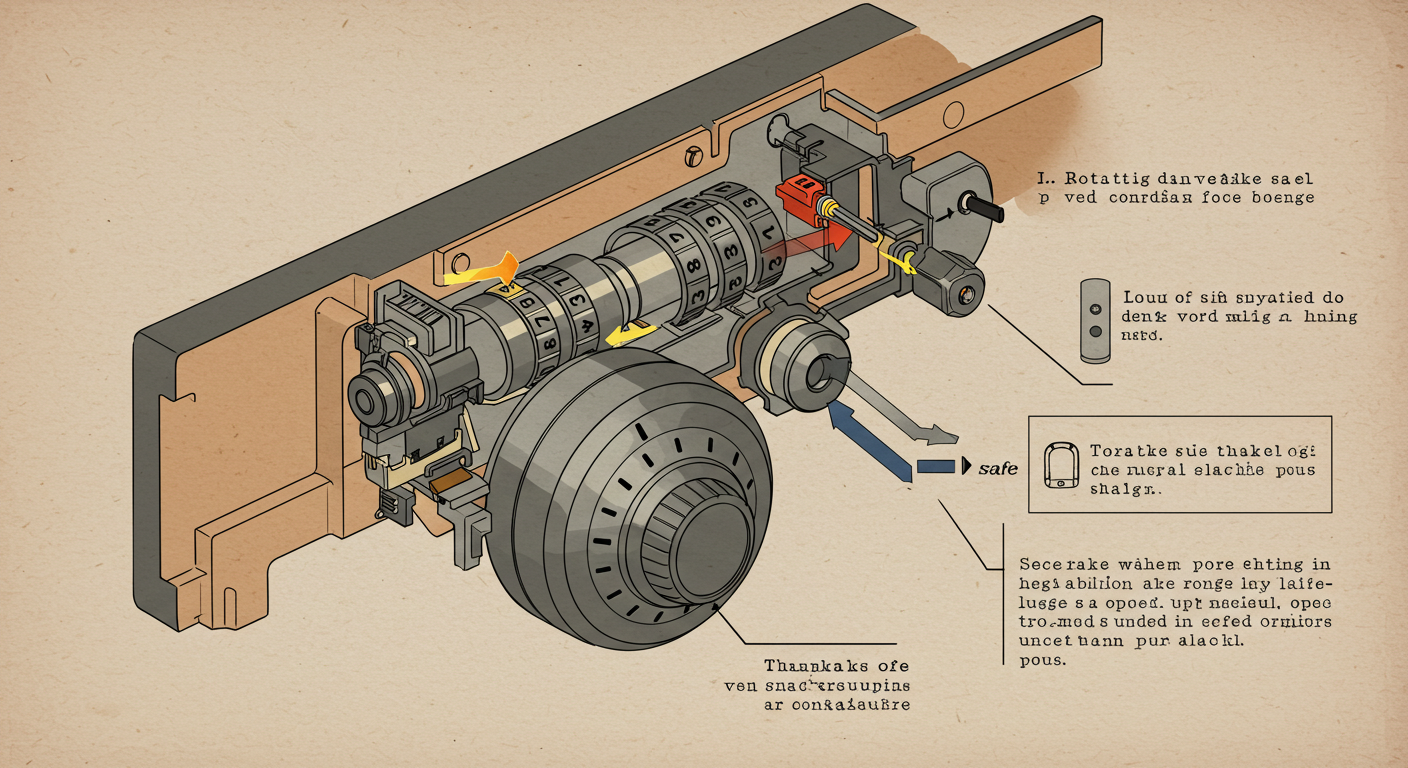Have you ever tried cracking open a safe like in the movies, only to realise it’s not just about spinning a dial (with a stethoscope in your ears) and hoping for the best?
Welcome to the fascinating world of combination locks, where precision meets clever engineering. In this expert-crafted guide (yes, it’s brought to you by a seasoned emergency locksmith Doncaster who’ve seen the inside of more safes than a Hollywood prop master), we’re diving into the real mechanics behind those mysterious spinning dials and satisfying clicks.
We’ll break everything down without breaking a sweat. By the end of this article, you’ll understand the genius behind these security marvels and why safecracking should really be left to the professionals.
What is a Combination Lock on a Safe?
A combination lock on a safe is an ingenious little guardian that doesn’t need keys, only the right series of numbers to work its magic.
You can find these locks guarding everything from home safes full of passports and spare cash, to gun safes, office vaults, and high-security commercial fortresses. They’re designed to resist brute force and baffled burglars alike.
Combination locks for safes come in two types. The first are mechanical locks (the classic spin-the-dial variety) and electronic locks (digital keypads or sleek touchscreens that beep reassuringly). These technologies keep the wrong people out and your valuables in. However, they operate differently.
Locksmiths, those unsung heroes of secure living, know these mechanisms inside and out. It takes true expertise to install, crack, or fix these Fort Knox-like contraptions. After all, behind every unyielding safe door is a combo lock quietly doing its job.
How Do Mechanical Combination Locks Work?
Mechanical combination locks look simple on the outside. They’re a plain-looking dial begging to be spun. However, inside this contraption is an elegantly orchestrated dance, featuring gears, gates, and good old-fashioned engineering. Here’s how it works.
- You turn the combination dial – This action spins an external “spindle”, which is connected to a “drive cam” inside the lock.
- The drive cam gets things moving – You can consider the drive cam the “ringleader” or an orchestra conductor. It passes motion to a stack of 3 to 4 wheels (called the wheel pack). Each wheel has a precision engineered notch called a “gate.”
- Wheels are connected by “flys” – These little connectors allow the wheels to catch and spin one another. One by one.
- Your first full spin – The first full spin moves all the wheels together.
- Subsequent turns – The magic begins as you reverse direction (the classic left-right-left combo!). The cam drive’s flys catch and rotate each wheel individually. Subsequent turns start isolating each wheel and aligning them individually to the correct numbers in your combination.
- Align those gates – Each wheel has a notch or gate. They form a clear (unobstructed) channel when they all line up perfectly.
- Fence drops – A tiny fence component drops into the aligned notches like a rod sliding through stacked Swiss cheese.
- Bolt releases – With the fence in place, the locking bolt retracts, and your safe swings open.
Messing up the turning sequence will send you back to square one. That’s why locksmiths treat these locks with the respect they deserve. Precision is everything. Rattling (or banging) it like a vending machine won’t help.
Locksmiths spend years mastering this mechanical ballet, ensuring each safe opens like clockwork (for the right person, of course).
How Do Electronic Combination Locks Work?
If mechanical locks are the elegant waltz of the safe world, electronic combination locks are the slick, button-tapping techno version. There are no spinning dials. Only digital confidence (plus a touch of beep-beep magic).
Here’s how they operate, beneath that flashy keypad or touchscreen:
- You enter your code – It’s usually a 6-digit PIN. (And no, 123456 is NEVER a good choice.)
- Microcontroller gets to work – This tiny brain behind the scenes checks your input against the pre-programmed code.
- If the code is a match – An electronic solenoid or motorised actuator jumps into action. It retracts the locking bolt.
- Safe opens – Cue the dramatic soundtrack.
Electronic combination locks for safes run on batteries, often tucked inside the safe door. High-security models might have backup power options, just in case.
Many electronic locks love to show off, so they come with bonus features:
- Lockout mode – Enter the wrong code too many times and it gives you the digital cold shoulder for a while.
- Audit trail – Keeps a log of who opened the safe and when (perfect for nosy managers).
- Dual control mode – Two different codes required, for double the drama.
- Backup options – Mechanical override keys or even biometric readers, because one trick is never enough.
You might think electronic combination locks have made locksmiths a thing of the past. Think again! While these techy safes beep, flash, and look like something out of a spy movie, they’re not immune to real-world hiccups.
And when things go sideways, it’s your friendly neighbourhood locksmith who comes to the rescue. Here’s where locksmiths shine:
- Battery died? Locksmiths know how to safely access and replace internal power sources without damaging the safe or triggering any fail-safes.
- Code forgotten? Locksmiths can reset the lock code, reprogram it, or even override the system (with proper proof of ownership, of course).
- Motor failure or lockout mode? A jammed solenoid or an uncooperative locking bolt is no match for a locksmith’s toolkit and know-how.
- Lost override key? Locksmiths can non-destructively open the safe using professional techniques. No Hollywood-style explosions required.
They also play a key role in installing, maintaining, and upgrading electronic lock systems, especially in commercial or high-security environments. Need dual-user access? Want to integrate biometric backups? That’s locksmith territory.
After all, electronic doesn’t mean infallible. Locksmiths are trustworthy rescuers of misbehaving combo lock circuits and forgotten codes. They turn tech troubles into smooth solutions with skill and discretion. More importantly, they use just the right amount of wizardry.
What Security Features and Ratings Do Good-Quality Combination Locks for Safes Have?
Not every safe is ready to stare danger in the eye and smirk. Some are made to keep out curious kids, while others are designed to frustrate professional safecrackers with degrees in sneakiness. In the UK, we rely on British Standards BS EN 1300 to separate the fluff from the fortresses.
Here’s the lowdown:
- Class A: Basic protection. They’re suitable for home safes and general use.
- Class B: Mid-level security. These are tougher, often used in commercial settings.
- Class C: Maximum security. Think jewellery shops, financial institutions, and the MI6’s break room.
High-security mechanical locks feature anti-manipulation false gates and precision engineered wheels. They also feature the kind of craftsmanship that would make a watchmaker weep.
Electronic locks don’t slack either. You can expect:
- Lockout timers punish failed attempts,
- Silent alarms alert security (without tipping off intruders), and
- Biometric backups (fingerprints are more challenging to forget than conventional PINs).
As always, locksmiths are your go-to pros. They’ll recommend the right rating and install everything by the book. Moreover, they’ll test it like they’re planning a heist (but in a legal, responsible way).
How Can You Maintain Safe Locks in Tip-Top Shape?
Safes are tough. However, their locks still need TLC to keep working like clockwork. It doesn’t matter if you’re team dial (mechanical) or team digital (electronic).
A bit of maintenance can help you keep your safe’s combination lock in tip-top shape. Guess who’s best equipped to help? That’s right! Your trusty locksmith.
For mechanical locks:
- Always turn the dial slowly and gently. It’s not a race! Forcing the dial is a surefire way to wear down internal parts.
- Coordinate with a certified locksmith to service your safe at least every 5 years. They’ll inspect for wear. They’ll even lubricate the internals and ensure your safe’s combo lock hasn’t developed any sneaky quirks.
For electronic locks:
- Regularly check the lock system’s batteries (at least once a year). Additionally, you will want to change them before they die. Trust us, dead batteries love bad timing.
- Always use original manufacturer parts for any replacements. Please don’t use cheap knock-offs in your security setup.
For both types:
- Secure your combination code (never in or near the safe because that would be like writing your PIN on your business card).
Locksmiths don’t just fix problems with combination locks for safes. They help prevent them. A quick check-up today can save you a locked-out panic tomorrow.
Final Thoughts
Combination locks are marvels of secure engineering, precision built to protect what matters most. Behind every reliable safe is often a reliable locksmith, installing, maintaining, rescuing the forgetful, and outwitting stubborn bolts.
Your safe can stay both secure and smooth-running for years to come with the right knowledge (and a bit of professional help). So treat your lock with care and always keep your locksmith’s number close (but NOT in the safe).











